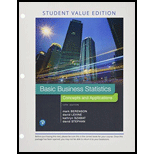
Concept explainers
Using the data of Problem 15.4 on page 600, stored in DomesticBeer, Perform a natural logarithmic transformation of the dependent variables (calories). Using the transformed dependent variable and the percentage of alcohol and the number of carbohydrates as the independent variables, perform a multiple
a. State the regression equation.
b. Perform a residual analysis of the results and determine whether regression assumptions are valid.
c. At the 0.05 level of significance, is there a significant relationship between the natural logarithm of calories and the percentage of alcohol and the number of carbohydrates?
d. Interpret the meaning of the coefficient of determination
e. Compute the adjusted
f. Compare your results with those in Problem 15.4 and 15.10. Which is best? Why?
Want to see the full answer?
Check out a sample textbook solution
Chapter 15 Solutions
Basic Business Statistics, Student Value Edition
- 19. Let X be a non-negative random variable. Show that lim nE (IX >n)) = 0. E lim (x)-0. = >arrow_forward(c) Utilize Fubini's Theorem to demonstrate that E(X)= = (1- F(x))dx.arrow_forward(c) Describe the positive and negative parts of a random variable. How is the integral defined for a general random variable using these components?arrow_forward
- 26. (a) Provide an example where X, X but E(X,) does not converge to E(X).arrow_forward(b) Demonstrate that if X and Y are independent, then it follows that E(XY) E(X)E(Y);arrow_forward(d) Under what conditions do we say that a random variable X is integrable, specifically when (i) X is a non-negative random variable and (ii) when X is a general random variable?arrow_forward

 Glencoe Algebra 1, Student Edition, 9780079039897...AlgebraISBN:9780079039897Author:CarterPublisher:McGraw HillAlgebra & Trigonometry with Analytic GeometryAlgebraISBN:9781133382119Author:SwokowskiPublisher:Cengage
Glencoe Algebra 1, Student Edition, 9780079039897...AlgebraISBN:9780079039897Author:CarterPublisher:McGraw HillAlgebra & Trigonometry with Analytic GeometryAlgebraISBN:9781133382119Author:SwokowskiPublisher:Cengage Functions and Change: A Modeling Approach to Coll...AlgebraISBN:9781337111348Author:Bruce Crauder, Benny Evans, Alan NoellPublisher:Cengage Learning
Functions and Change: A Modeling Approach to Coll...AlgebraISBN:9781337111348Author:Bruce Crauder, Benny Evans, Alan NoellPublisher:Cengage Learning



